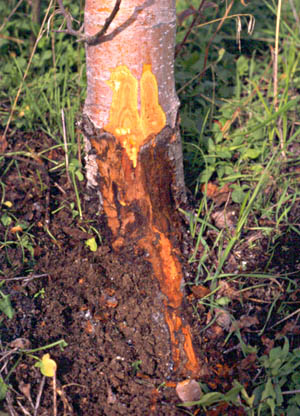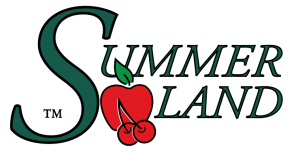Crown and Root Rot
General Description
Although crown rot is primarily a disease of apples in British Columbia, it has been identified on peaches, plums, apricots and cherries.
Symptoms:
In apples, the first sign of disease is usually a purple-red colouring of leaves in late August and early September. The following year, infected trees are either dead or unthrifty with pale, sparse leaves. The above-ground symptoms can be confused with other disorders such as winter injury.
To check whether tree decline may be due to crown rot, remove patches of bark at the base of the tree. Crown rot causes orange to red-brown discolouration in the cambium. Crown rot lesions are typically delineated by a dark, thin line between the discoloured lesion and healthy tissue. In time the diseased bark becomes soft and dark brown. On some trees, only the roots and not the crown show symptoms.
 |
| Apple infected with crown rot. (BCMA) |
Life Cycle
Crown and root rot is caused by several species of the soil-borne oomycete, Phytophthora. This fungus-like pathogen requires wet soil for spore production and tree infection. Trees between the ages of three and ten are most commonly affected.
Phytophthora can survive in the soil for long periods of time as oospores (resting spores). Infection is caused by zoospores (swimming spores) which are released from sporangia in wet soils.
Management
Cultural Control
-
Select rootstocks with resistance to crown rot for all new apple plantings.
-
Resistant rootstocks: M.9, M.27, B.9, G.11, G.16, G.30, G.41, G.65, G.202, G.935
-
Intermediate or variable resistance: M.2, M.4, M.26, MM111
-
Susceptible: M7, MM104, MM106
-
-
Select planting sites that are not prone to flooding or standing water.
-
Plant trees with the graft union above the soil surface.
-
Manage irrigation to avoid prolonged soil saturation or standing water around the base of trees.
-
Reduce nitrogen application on trees with excessive growth as they are more susceptible to crown rot.
Chemical Control
Bearing Apple Tees
Apply Aliette WDG (fosetyl al) as a foliar spray according to label directions during the tight cluster or pink stage when there is sufficient leaf area present to take up the spray. Repeat approximately 6 weeks later and in the fall soon after harvest. Do not treat within 30 days before harvest. Use a maximum 3 applications/year. Do not apply as a drench treatment on bearing trees. Do not tank mix with copper.
Non-bearing Apple Trees
Apply Aliette WDG as a high volume coarse spray using a handgun to drench the trunk and soil surrounding the tree. Refer to the label for rates and application instructions. Make the first application in spring after silver tip and again in early fall. Do not apply as a drench more often than twice per year. Aliette may also be applied to non-bearing trees as a foliar spray if there is sufficient foliage present for good uptake of the chemical.
Ridomil Gold 480 EC (metalaxyl-m) may be applied to non-bearing apple trees only. Apply as a soil drench according to label instructions at time of planting and/or in late August. Treatments can be repeated in early spring and late August in each subsequent non-bearing year, if needed. Do not mix Ridomil with herbicides.
CAUTION - Resistance to Ridomil has already been observed for related species of Phytophthora. Indiscriminate use of Ridomil may result in the development of resistant crown rot fungus. Use only when necessary.
Updated January, 2017
